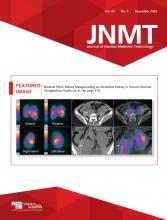Abstract
The process of bringing a new drug to market is complex and has recently necessitated a new drug-discovery paradigm for the pharmaceutical industry that is both more efficient and more economical. Key to this task has been the increasing use of nuclear medicine and molecular imaging to support drug discovery efforts by answering critical questions on the pathway to development and approval of a new therapeutic drug. Some of these questions include whether the new drug reaches its intended target in the body at sufficient levels to effectively treat or diagnose disease without unacceptable toxicity; how the drug is absorbed, metabolized, and excreted; and what the effective dose is in humans. To conduct the appropriate imaging studies to answer such questions, pharmaceutical companies are increasingly partnering with molecular imaging departments. Nuclear medicine technologists are critical to this process, as they perform scans to collect the qualitative and quantitative imaging data used to measure study endpoints. This article describes preclinical and clinical research trials and provides an overview of the different ways that radiopharmaceuticals are used to answer critical questions during therapeutic drug development.
Footnotes
CE credit: For CE credit, you can access the test for this article, as well as additional JNMT CE tests, online at https://www.snmmilearningcenter.org. Complete the test online no later than December 2025. Your online test will be scored immediately. You may make 3 attempts to pass the test and must answer 80% of the questions correctly to receive 1.0 CEH (Continuing Education Hour) credit. SNMMI members will have their CEH credit added to their VOICE transcript automatically; nonmembers will be able to print out a CE certificate upon successfully completing the test. The online test is free to SNMMI members; nonmembers must pay $15.00 by credit card when logging onto the website to take the test.
Published online Jun. 14, 2022.







